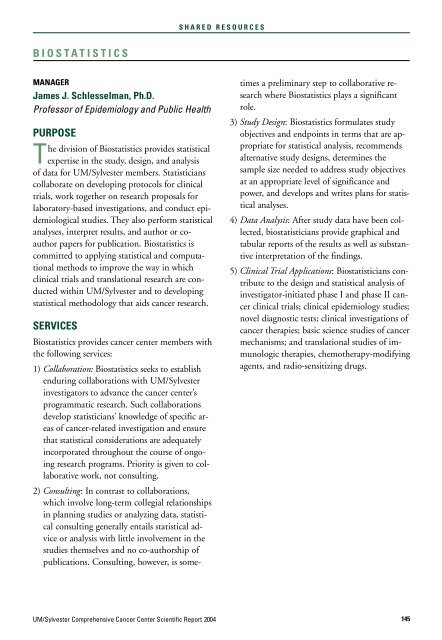SCIENTIFIC REPORT 2004 - Sylvester Comprehensive Cancer Center
SCIENTIFIC REPORT 2004 - Sylvester Comprehensive Cancer Center
SCIENTIFIC REPORT 2004 - Sylvester Comprehensive Cancer Center
Create successful ePaper yourself
Turn your PDF publications into a flip-book with our unique Google optimized e-Paper software.
S H A R E D R E S O U R C E S<br />
B I O S T A T I S T I C S<br />
MANAGER<br />
James J. Schlesselman, Ph.D.<br />
Professor of Epidemiology and Public Health<br />
PURPOSE<br />
The division of Biostatistics provides statistical<br />
expertise in the study, design, and analysis<br />
of data for UM/<strong>Sylvester</strong> members. Statisticians<br />
collaborate on developing protocols for clinical<br />
trials, work together on research proposals for<br />
laboratory-based investigations, and conduct epidemiological<br />
studies. They also perform statistical<br />
analyses, interpret results, and author or coauthor<br />
papers for publication. Biostatistics is<br />
committed to applying statistical and computational<br />
methods to improve the way in which<br />
clinical trials and translational research are conducted<br />
within UM/<strong>Sylvester</strong> and to developing<br />
statistical methodology that aids cancer research.<br />
SERVICES<br />
Biostatistics provides cancer center members with<br />
the following services:<br />
1) Collaboration: Biostatistics seeks to establish<br />
enduring collaborations with UM/<strong>Sylvester</strong><br />
investigators to advance the cancer center’s<br />
programmatic research. Such collaborations<br />
develop statisticians’ knowledge of specific areas<br />
of cancer-related investigation and ensure<br />
that statistical considerations are adequately<br />
incorporated throughout the course of ongoing<br />
research programs. Priority is given to collaborative<br />
work, not consulting.<br />
2) Consulting: In contrast to collaborations,<br />
which involve long-term collegial relationships<br />
in planning studies or analyzing data, statistical<br />
consulting generally entails statistical advice<br />
or analysis with little involvement in the<br />
studies themselves and no co-authorship of<br />
publications. Consulting, however, is sometimes<br />
a preliminary step to collaborative research<br />
where Biostatistics plays a significant<br />
role.<br />
3) Study Design: Biostatistics formulates study<br />
objectives and endpoints in terms that are appropriate<br />
for statistical analysis, recommends<br />
alternative study designs, determines the<br />
sample size needed to address study objectives<br />
at an appropriate level of significance and<br />
power, and develops and writes plans for statistical<br />
analyses.<br />
4) Data Analysis: After study data have been collected,<br />
biostatisticians provide graphical and<br />
tabular reports of the results as well as substantive<br />
interpretation of the findings.<br />
5) Clinical Trial Applications: Biostatisticians contribute<br />
to the design and statistical analysis of<br />
investigator-initiated phase I and phase II cancer<br />
clinical trials; clinical epidemiology studies;<br />
novel diagnostic tests; clinical investigations of<br />
cancer therapies; basic science studies of cancer<br />
mechanisms; and translational studies of immunologic<br />
therapies, chemotherapy-modifying<br />
agents, and radio-sensitizing drugs.<br />
UM/<strong>Sylvester</strong> <strong>Comprehensive</strong> <strong>Cancer</strong> <strong>Center</strong> Scientific Report <strong>2004</strong> 145
















